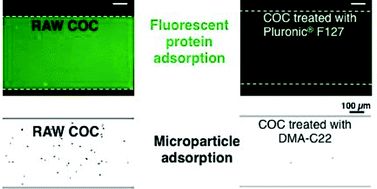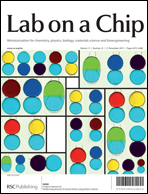New non-covalent strategies for stable surface treatment of thermoplastic chips
Abstract
In order to be more extensively used outside of research laboratories, lab-on-chip technologies must be mass-produced using low-cost materials such as thermoplastics. Thermoplastics, however, are generally hydrophobic in their native state, which makes them unsuitable for direct use with biological samples in aqueous solution, and thus require surface coating. This coating should be robust, inexpensive and simple to implement, in order not to hinder the industrial advantage of thermoplastic chips. Cyclic Olefin Copolymer (COC) is a particularly appealing polymer, but it is also difficult to functionalize due to its chemical inertness. Here we introduce and compare the performance of two new approaches for COC coating. One relies on the use of a commercial triblock copolymer, Pluronic® F127. The second approach uses new copolymers synthesized by radical polymerization, and consisting of a dimethylacrylamide (DMA) backbone carrying aliphatic side chains (C22). Two DMA-C22 copolymers were synthesized with various C22/DMA ratios: DMA-S at 0.175% and DMA-M at 0.35%. Different physicochemical properties of the polymers such as critical micellar concentration (CMC), water contact angle, electroosmosis were investigated. Coated COC chips were then tested for their ability to reduce the adsorption of proteins, microparticles, and for protein electrophoresis. For each application we found an optimal treatment protocol to considerably improve the performance of the thermoplastic chip. These treatments use physisorption in situ which requires no photografting or chemical reaction and can be performed by a simple incubation either after chip production, or just prior to use.


 Please wait while we load your content...
Please wait while we load your content...